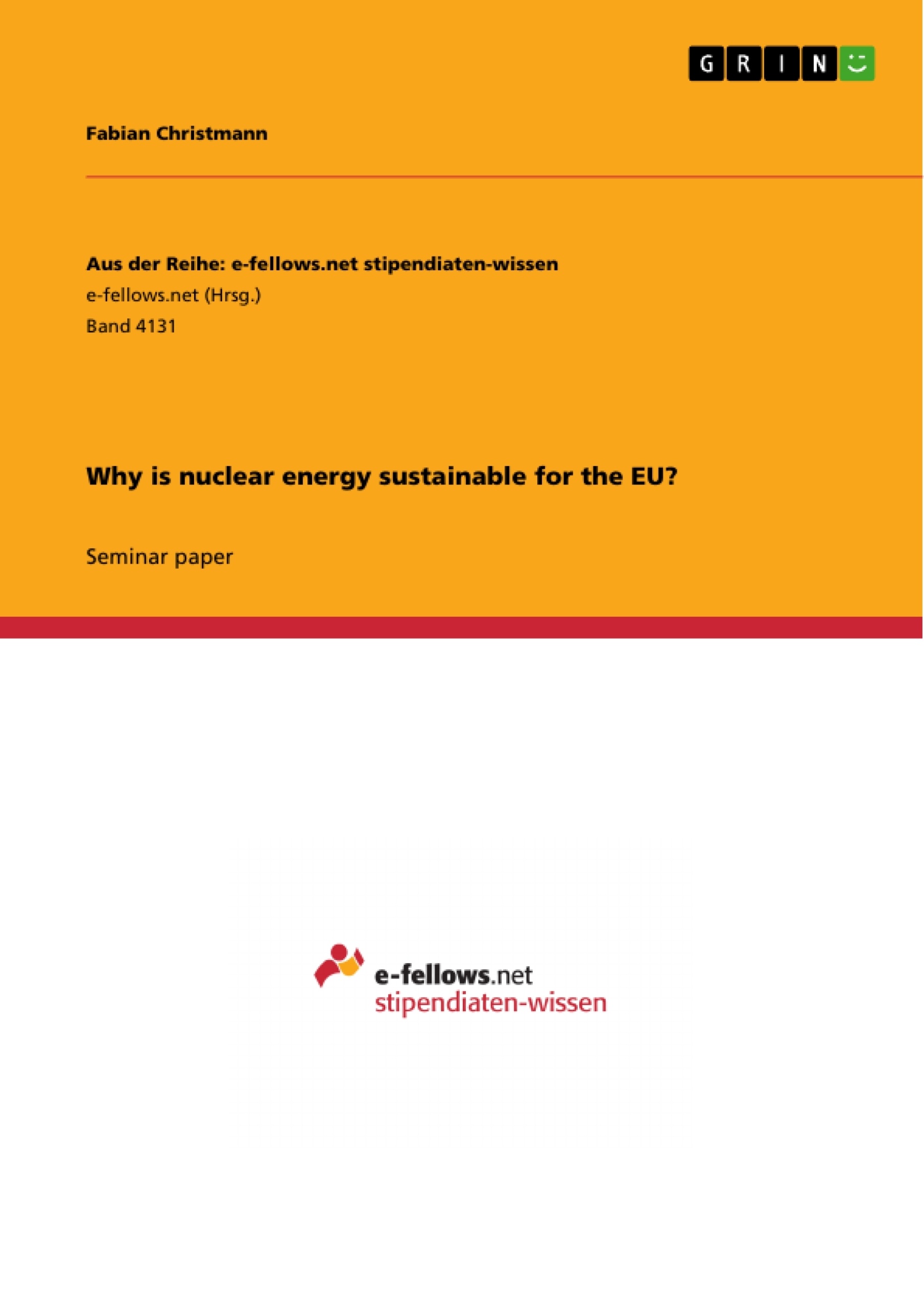This paper is going to cover the question Why is nuclear energy sustainable for the EU? with a focus on the discussion from 2020 to 2022. In doing so, firstly the groundwork of the European Green Deal will be laid out in chapter 2 and the necessity for action will be derived, specifically the use of and classification of nuclear energy as sustainable and green. The EU Taxonomy and consequent line of argument for including nuclear energy in the Taxonomy will be presented in chapter 3 using the reports by the Technical Expert Group (TEG) and the Joint Research Centre (JRC), which conclude that nuclear energy has close to no greenhouse gas emissions and, regarding the latter report, meets the criterium of do no significant harm (DNSH). Chapter 4 will focus on criticism of the EU Taxonomy, mainly the analysis by the JRC and its risk assessment. In chapter 5 both sides will be considered when discussing whether nuclear energy should be considered green, weighing the factor of fear and risk statistics, and arguing why a fear-based anti-nuclear approach, such as the one observed in Germany, is in fact worsening the climate effect rather than helping reach the EU’s goals. Finally, the conclusion will include an outlook on current developments.
Climate change and global warming are amongst the most severe challenges faced by mankind today. Fossil fuel-based energy sources have greatly contributed to man-made rise in temperature. They are still necessary contributors in meeting global energy demands, yet cleaner, more sustainable, and efficient sources must be adapted in order to ensure a future for both humanity and the planet. Hence, the European Union (EU) seeks to be a global leader in reaching climate goals and transitioning towards sustainable forms of energy production. To achieve this, the European Union has set itself clear goals. Meeting these goals requires regulations steering not only national but also private market players towards a greener future.
In 2022 the EU decided to include gas and nuclear energy in its Taxonomy, declaring them to be green technologies. This has been met with vast outcries from ecological organisations and led to the accussation of green washing to meet the EU’s goals (Reclaim Finance 02.02.2022). Surely it might seem counterintuitive to suddenly declare formerly non-green technologies to be green. It is important to understand, why the EU changed its definition.
Inhaltsverzeichnis (Table of Contents)
- Introduction
- European Green Deal
- Nuclear energy as a green technology under EU Taxonomy
- Technical Expert Group Report
- Joint Research Centre Report
- Criticism of the EU Taxonomy
- Should nuclear energy be considered green?
- Conclusion
Zielsetzung und Themenschwerpunkte (Objectives and Key Themes)
This paper aims to investigate the rationale behind the EU's decision to classify nuclear energy as a sustainable and green technology, focusing on the discussion from 2020 to 2022. It delves into the European Green Deal's goals and the need for sustainable energy sources, examines the arguments for and against nuclear energy's inclusion in the EU Taxonomy, and analyzes the potential impact of this decision on climate action within the European Union.
- The European Green Deal and its objectives for climate neutrality
- The EU Taxonomy and its classification of sustainable economic activities
- The role of nuclear energy as a low-carbon energy source
- The debate surrounding the inclusion of nuclear energy in the EU Taxonomy
- The potential impact of the EU's decision on climate action and energy policy
Zusammenfassung der Kapitel (Chapter Summaries)
- Introduction: This chapter introduces the paper's topic and sets the context by highlighting the global challenge of climate change and the EU's ambition to lead the transition to sustainable energy production. It emphasizes the need for efficient energy sources and explains the controversial decision to include nuclear energy in the EU Taxonomy.
- European Green Deal: This chapter delves into the European Green Deal, its ambitious climate goals, and the necessary investments to achieve them. It discusses the importance of public and private sector involvement, the role of fear in public discourse surrounding climate change, and the need for a secure, sustainable, and competitive energy system. It concludes by explaining the necessity for a clear definition of sustainable economic activities to guide investments.
- Nuclear energy as a green technology under EU Taxonomy: This chapter explores the EU Taxonomy's classification system and its significance for financing sustainable growth. It highlights the inclusion of renewable energy sources and focuses on the controversial decision to include nuclear energy. The chapter discusses the arguments for nuclear energy's inclusion, highlighting its low carbon emissions and its potential to meet baseload energy demand.
Schlüsselwörter (Keywords)
This paper focuses on the key concepts of climate change, sustainable energy, the European Green Deal, the EU Taxonomy, nuclear energy, and the do no significant harm (DNSH) criterion. It explores the debate surrounding the inclusion of nuclear energy in the EU Taxonomy and analyzes the implications of this decision for climate action and energy policy.
- Citar trabajo
- Fabian Christmann (Autor), 2022, Why is nuclear energy sustainable for the EU?, Múnich, GRIN Verlag, https://www.grin.com/document/1239913



